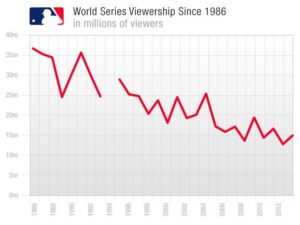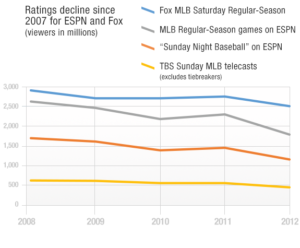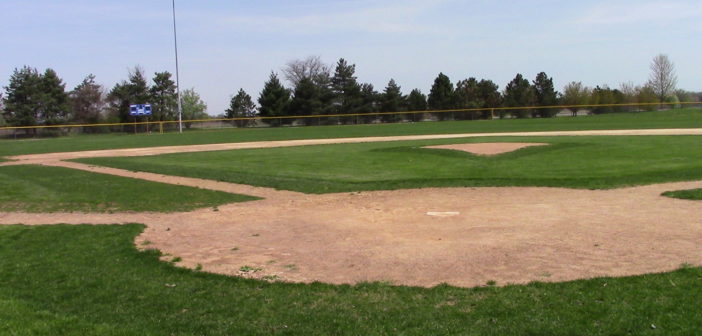Charming scene, isn’t it? Patches of grass growing on the infield dirt. Grass fading in areas where it should be plentiful. The quality of the dirt looks old and improperly maintained. All of these characteristics are evident before the beginning of the baseball season. How can teams practice on such a poorly maintained infield? I guess a better question would be this:
Does anybody care?
Baseball was once referred to as the national pastime in the United States. What was once the most popular sport in America, baseball is now struggling to attract and maintain a younger audience at the major league level, as well as participation in youth leagues. In a technology-driven world with so much to do, baseball appears not to be on the younger generation’s radar.
Technology, cost and specialization
In “The Decline of Baseball and Why it Matters,” Huffington Post writer Laura Hanby Hudgens uncovers reasons and explains why baseball is declining in popularity and involvement among youth. The article points to several reasons as to why the younger generation isn’t getting involved in baseball: technology, cost and specialization.
In today’s society, kids and adults alike want constant entertainment and interaction; technology provides all of that. Why do you think so many kids spend a great deal of their time on smartphones?
Think about it. It’s odd if you see a person walking down a street or waiting in a line and they’re not looking at their phone.
Technology stimulates our brains and provides us with the constant entertainment and interaction we want. For many, it is even addictive. Contrary to technology, baseball is a slow-moving, thought-provoking game that doesn’t provide kids with that same entertainment and stimulation they desire.
“Baseball is also a thinking game. In some ways, it requires more patience and concentration than football or basketball. There are less hustle and more calculation. For kids used to instant entertainment and near constant stimulation, baseball can seem boring,” said Hudgens.
Cost is also an important factor in the decision to participate in sports and it is related to most of the decisions we make each and every day. According to Hudgens, the cost of travel mixed with the cost of equipment can really put a dent in someone’s wallet. In many cases, the cost is too much of an obstacle for some families to overcome.
Next, we have specialization, which is a contributing factor as to why fewer kids are playing youth baseball. Specialization, in this context, is when kids focus on one sport or one position in a sport, like a shortstop. Many kids, along with their parents, decide it is best to focus on one sport and improve their skills. Most of the time, this particular concept, while nice in thought, does not yield the results we are hoping for or expecting.

Crystal Lake Babe Ruth Baseball field/Photo by Chris Roemeling
When kids specialize in one position, they are constantly working the same muscle groups, which makes them prone to injury. Consistently working the same muscle can wear it down or tire it out. After badly injuring oneself playing the same sport or position, is it predictable that they might not want to return to the sport? Yes.
Additionally, kids who decide to specialize in baseball may get tired of it too quickly. The normal passion and excitement of having to play two games during a week in the summer turns into having to play games year-round. Passion and excitement might fade after constant hours and preparation of the same activity over and over again.
What about the opposite side of the spectrum? What about the kids who decide not to specialize in baseball and play for fun? How do they stack up against the kids who specialize and devote most of their time to one sport?
“So the boys on these teams naturally get in a lot more practice. When summer rolls around again, some kids’ only experience with the game is getting clobbered by teams who play several months out of the year. For these kids, soon baseball just isn’t that fun anymore,” said Hudgens.
And that’s the most important thing, isn’t it? Having fun?
Jake Hartman, vice president of Crystal Lake Little League Baseball, offered his insight on this issue.
“The rate of play has to pick up. Kids’ attention spans are very short. We have to find ways to make the game exciting and fun,” said Hartman.
Pace of play and length of season
The fact of the matter is there are numerous reasons as to why baseball isn’t attracting the younger generation. Many little reasons will surface here and there, but the main reasons have always existed. The main causes of the decline in popularity are the sport’s pace, as well as the length of the season.
North Central College Athletic Director James Miller discusses baseball and reality:
Ed Mathey, head coach of the North Central Cardinal’s Men’s baseball team, has been around baseball for much of his life and has noticed the decline. It would be hard not to.
“The nature of the game is slow-paced. There’s a little more downtime. Kids like action, kids like moving. You don’t always get the results you want in baseball; it’s a tough game to be proficient at. Youth coaches need to find a way to continue to make the game more fun, continue to make practice fun, and continue to make games fun. Kids want to have fun,” said Mathey.
Participation in youth baseball is not the only area in which baseball is seeing a decline. Major League Baseball is also having issues with their audience.
In a 2015 Washington Post article titled, “Baseball is struggling to hook kids — and risks losing fans to other sports,” Marc Fisher discusses issues surrounding professional baseball, as well as youth participation. According to Nielsen ratings, as discussed in the article, “50 percent of baseball viewers are 55 or older, up from 41 percent 10 years ago.”
“ESPN, which airs baseball, football and basketball games, says its data show the average age of baseball viewers rising well above that of other sports: 53 for baseball, 47 for the NFL (also rising fast) and 37 for the NBA, which has kept its audience age flat,” said Fisher.
According to Fisher, even MLB Commissioner Rob Manfred is concerned about the future of baseball when he issued a warning of how baseball must adapt, or it could lose a generation of fans.
“On the opening day of the 140th season since the National League was founded, baseball’s following is aging. Its TV audience skews older than that of any other major sport, and across the country, the number of kids playing baseball continues a two-decade-long decline,” said Fisher.
These are startling facts for the MLB, as well as youth baseball leagues. Adaptations to fit the lifestyle of kids need to be made in order to preserve the future of the sport.
“…The pervasive impact of new technologies on how children play and the acceleration of the pace of modern life have conspired against sports in general and baseball in particular,” said Fisher.
One solution that’s often discussed is decreasing the number of games in a season. Honestly, does the season really need to be 162 games? Really? Maybe adaptations to fit the lifestyle of a younger audience will bring them back to the sport? Bulls/Sox Academy’s Retention and Customer Service Manager Joe Loburgio provided his opinion on the length of the season.
“We have to make the games a little more important. Cut off a month of the season for better timing. If possible, have earlier start times for kids,” said Loburgio.
Length of the season often drags, but what about the pace of an individual game? It would be foolish to discuss the nature of the decline in baseball and not address the pace of the game. Typically, a baseball game can last anywhere from three to four hours. In fact, if you want to watch a Red Sox and Yankees game, you might want to be prepared to sit on your couch for five hours. Maybe more.
But the fact is people don’t want to watch a game for nearly five hours. We’ve all heard people compare watching baseball to watching paint dry. Why is it that viewership has decreased so much over the years? The answer is simple; it’s due to other substitutes, pace of play, technology, length of the season, etc.
NCC Assistant Baseball Coach Joe Heller provides his opinion on technology and baseball:
But how does the MLB compare to the NFL and NBA? Odyssey Online writer Matthew Corwin briefly compares the MLB to the NFL and NBA in a 2016 article titled, “The Gradual Decline of Baseball Popularity.”
“For the last few years the ratings of the World Series have dropped. Compare that to the Super Bowl or the NBA Finals, both of which ratings have risen. Then compare the ratings to the World Cup and the Olympics, and it may come to reason that baseball is becoming less popular than it once was,” said Corwin.
However, no reason is more important than pace. Baseball is actually destroying its own game through its pace of play. Think about it. We often hear people discuss how watching baseball is more boring than watching paint dry or grass grow, which might be an exaggeration. Maybe.
Take a look at the graph below where World Series viewership is examined from 1986 to 2012.

“How the Golden Age of Television and Baseball Ends,” Motley Fool
Obviously, people have been deciding not to watch the World Series. Accompanied by steady and alarming decreases in viewership, baseball is now bleeding. If people are choosing not to view baseball’s biggest, most exciting event, then why should the league and owners expect people to watch regular season games?
Well, maybe more and more people are watching paint dry. Great job maintaining your fan base, baseball.
Motley Fool writer Eric Bleeker takes an in-depth look at the game of baseball in his article titled, “How the Golden Age of Television and Baseball Ends.”
“The World Series, the showcase of baseball’s empire, is no more popular than an airing of ‘The Big Bang Theory’ on CBS,” said Bleeker.
Give the MLB some credit (wink). Baseball has been trying to attract people to the game, unsuccessfully. Ignoring the problems that drive people away from the game is a well thought out strategy, right? Game of the Week, Fox’s apparent strategy to draw people to baseball through their showcase of exciting players and exciting teams, was nothing more than a failed attempt.
According to Bleeker, Game of the Week’s viewership dropped 33 percent between 2004 and 2012. Ratings also saw a decline on ESPN.

“How the Golden Age of Television and Baseball Ends,” Motley Fool
As anyone can see, Fox is not the only outlet experiencing sharp decreases in ratings. What more can be said about baseball at this point? Why is this happening?
Bleacher Report writer Peter Panacy sums it up in his article titled, “MLB: How Major League Baseball is Losing its Appeal in the Modern Era.”
“Baseball requires the knowledge and patience of fans much more than any of the other major sports. It also lacks the fast-paced and action-packed intrigue compared to other sports as well,” said Panacy.
Heller on pace of play:
Pace of play and the duration of the game have always been discussed. For years, people complained about the length of the game and how it’s too much for them, but no one listened. Fans agonized about the length of the game, but those complaints would often fall on deaf ears.
Finally, the casual fan’s prayer was answered once the MLB instituted several rule changes for the 2017 season in what they hoped would speed up the pace of the game, as well as add more excitement. In an article from Bleacher Report, “Full List of MLB Rule Changes for 2017 Season,” Adam Wells discusses several new rule changes to the game of baseball.
According to Wells, one of the rule changes gets rid of the four-pitch intentional walk. When a team wants to intentionally walk a hitter, now they don’t have to throw any pitches, which shaves off roughly 40 seconds of the game. Way to go, baseball.
Another big rule change is seen through the use of replay. According to the article, managers have only 30 seconds after the conclusion of a play to determine whether or not they want to challenge. Compare this change to replays in the past where managers would tell the player to wait out on the field while another coach reviews the play to see if it’s worth challenging. It might not sound like much, but it is a significant change. Many fans didn’t even want instant replay to be instituted in baseball in the first place because they worried it would make the game substantially longer.
Heller on the reality of baseball:
The rule also applies to replay officials in New York. Replay officials from MLB’s replay center now only have a two-minute time limit to review the play. These rule changes will hopefully impact the sport in a positive way because, as we all know, this sport needs something positive. It needs the younger generation. Baseball needs youth viewership and participation to grow the game.
But for all those baseball purists out there, the game is not fine. Baseball is not doing better than ever. Baseball is hurting. Why else would there be rule changes? If professional baseball and youth baseball were in good shape, this wouldn’t even be a conversation.
Editor’s note: Photos, video, audio and editing by Chris Roemeling

